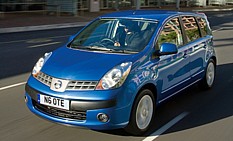Review
In its place is the Note, a far more convincing attempt at a small car which can cater for the needs of a family.
The two cars differ in many ways – the Note is smaller than the Tino, the Note looks better than the Tino, drivers better than the Tino...
In fact, the Note is a very, very good car, blending compact exterior dimensions with a surprisingly spacious interior.
Although based on the same chassis and running gear as the Micra and Renault Clio, the Note is a much bigger vehicle than a traditional supermini. The body is taller, longer and wider than the Micra, resulting in an interior which can seat five adults and has decent boot space.
And as it’s marketed as an MPV, the Note features an array of storage and seating functions. The rear seat bench can be moved fore or aft to either increase boot space or rear legroom, and the boot has a twin-floor arrangement which features a hidden compartment underneath the usual load floor.
The cabin also boasts the usual array of storage binnacles, plus aircraft-style tables which fold out from the back of the front seats.
Another thing which impresses about the cabin is the feeling of quality. The standard of materials used is first rate, everything feels well put together and likely to stand the test of (family) time.
It’s also logically designed, with the air conditioning contained in two dials and the stereo/CD mounted high up on the dashboard so it’s at the driver’s eye level and also not too far away to reach.
Practicality and useability are the key words here, which usually means the driving experience is pretty ropey. But this isn’t true with the Note. While in turbodiesel form it’s no ball of fire, the 1.5-litre dCi engine makes a decent fist of offering enough performance to avoid being embarrassing.
The car also handles fairly well, with body roll well contained in cornering. The pay-off for this is a jittery ride, although it’s not enough to class as uncomfort-able, just mildly annoying.
The steering set-up is also not quite right. It has a very direct feel and response from the front wheels is instantaneous, but there’s a weird feeling around the dead-ahead, almost like the initial turn action is being done through an elastic band.
But these are minor niggles as the Note is not designed to be a driver’s car – it is marketed to appeal to young families, and in this respect Nissan’s new challenger is playing exactly the right tune.
Fact file:
P11D value: £11,842
CO2 emissions (g/km) : 136
BIK % of P11D in 2006: 18%
Graduated VED rate: £110
Insurance group: 4
Combined mpg: 55.6
CAP RV (3yr/60k): £4,025/34%
Monthly lease (3yr/60k): £265
At a glance
Three rivals to consider
P11D price
Meriva £10,937
Modus £11,612
Fusion £11,692
Note £11,842
THE Note is the most expensive, but in SE trim it comes with plenty of equipment which isn’t standard on its rivals, such as rear electric windows, air conditioning, CD player, heated and electrically-adjustable door mirrors. The Meriva is cheap but lacks equipment.
Emissions and tax rates
Fusion 119g/km/18%
Modus 119g/km/18%
Meriva 135g/km/18%
Note 136g/km/18%
ALL four cars fall into the lowest benefit-in-kind tax band for diesel cars, so all that separates them is their front-end price. The Meriva leads the way with a company car tax bill of £36 a month for a 22% taxpayer. The Fusion and Modus will both cost £38 and the Note £39.
SMR cost
ppm 60k total
Fusion 2.25 £1,350
Meriva 2.36 £1,416
Note 2.97 £1,782
Modus 3.11 £1,866
AROUND £500 separates the cheapest and most expensive cars in service, maintenance and repair costs over 60,000 miles. The Ford and Vauxhall lead the way thanks to their lower garage labour rates, with the Nissan and Renault hovering around the 3ppm mark.
Fuel cost
Fusion 7.18 £4,308
Modus 7.18 £4,308
Meriva 7.98 £4,788
Note 8.11 £4,866
THE Modus and Note share the same diesel engine, but the Renault is more efficient, returning 62.8mpg compared to the Nissan’s 55.6mpg. This is due to weight – the Nissan is bigger than the Modus and weighs 100kg more. The Ford averages 62.8mpg and the Vauxhall 56.5mpg.
Depreciation cost
Note 12.90 £7,744
Meriva 12.93 £7,758
Fusion 13.19 £7,914
Modus 13.47 £8,082
AS befits its newness, the Note has the best RV, with CAP predicting it will retain 34% of its cost new after three years and 60,000 miles – leaving a cash lost figure of £7,744.
The Ford retains 32%, the Renault 30% and the Vauxhall 29% – but its low price helps it to second here.
Wholelife cost
Fusion 22.62 £13,572
Meriva 23.27 £13,962
Modus 23.76 £14,256
Note 23.98 £14,388
WITH the lowest SMR bill and joint-lowest fuel bills, the Fusion leads the way on running costs, costing a fleet around £13,500 over three years/ 60,000 miles. The Meriva is second thanks to a strong showing in the depreciation section, and will cost around £400 more than the Ford.
Verdict
THERE can only be one winner here – the Nissan Note. Yes, it costs more than the others to buy, will set a driver back slightly more in company car tax and will cost a fleet more to run (but not prohibitively so), but it is the best car here.
Factor in the extra equipment, the more spacious interior and the quality feel and the Nissan is worth the extra outlay. From the poor Almera Tino, Nissan has fashioned a winning recipe with the Note.


















